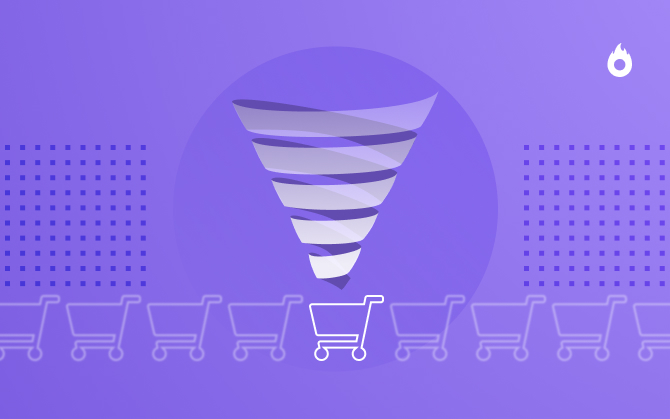
What Is a Sales Funnel and How Do You Use It in Your Business?
Learn how to use this tool to better understand your leads’ journey up to the moment they become your customers!

What will we see in this post
When it comes to Inbound Marketing, the marketing sales funnel is an indispensable tool. With it, you can better understand the buyer’s journey and her needs, creating rich content for each stage the customer goes through.
Therefore, the marketing sales funnel is a powerful ally to the entrepreneur, as it enables to optimize the number of conversions.
But although it is widely used by digital entrepreneurs, this stool still raises many questions for those who are just starting out.
That’s why we have prepared a step-by-step for you to create a sales funnel that is specific to your customers’ needs.
Find out now who to make the best of the sales funnel and ensure the best results for your business.
The origin of the term ‘sales funnel’
Despite having become more popular recently, the concept of the marketing sales funnel is actually relatively old.
In 1898, E. St. Elmo Lewis introduced to the world what is the typical stages a customer goes through in the purchasing process. According to his model, the sale of any product starts with attraction, moves on to interest, desire, and finally, action.
In conceptual terms, the sales funnel is a strategic model based on the buyer’s journey, from the first interaction with the product until the decision to make the purchase.
With it, it is possible to guide the customer in potential with rich materials, which are able to answer questions and meet the needs people have, making the arrive at the conversion stage intuitively.
By the end of the stages, the customer in potential may become a real customer, or even a fan of the brand, making more purchases in the future.
What about an example to illustrate?
If someone needs to buy a shirt for a social event, for instance, it starts with the problem in general: the need to acquire a specific item of clothing for the event.
After having identified the problem, the customer in potential will start to look for available options of shirts, trying to find which model would be the most appropriate. Finally, the decision to make the purchase will be made.
As you can see, there are many stages in the marketing sales funnel, starting with a general problem, all the way to a specific solution.
The stages of a marketing sales funnel
As we mentioned above, the sales funnel is made up of some stages, from the first interaction with the product until the decision to make the purchase.
Let’s see what these stages are!
1. Attract
‘Attract’ is the first stage in the marketing sales funnel.
In it, the content created must be broad, to enable the customers to recognize their individual needs.
As it represents the first contact between customer and brand, the materials have to be rich in information, and not talk about the product itself.
Every piece of content must be created taking into account that the buyer persona is not completely aware of their needs and problems. Thus, it is up to the customers themselves to identify with the subject, showing interest in moving through the sales funnel.
View this post on Instagram
Keeping an up-to-date blog with high-quality content is an excellent strategy to nurture leads from the top of the funnel.
2. Convert
After the initial awareness stage, also known as the ‘attract’ stage, the sales funnel starts to narrow down towards the ‘convert’ stage.
At this moment, the reader is brought close to the brand and product. It is precisely then that the entrepreneur will start to collect leads, that is, customers in potential, with the right characteristics of an ideal buyer.
Making use of a Landing Page is an excellent strategy to get the permission of the reader to build a closer, more personalized contact.
If you have never heard of Landing Pages, they are pages with appealing and intuitive content that aim to stimulate the visitor to perform an action, such as downloading an ebook or signing up for a newsletter, for example.
(Check out our post with 10 tools to create your Landing Page on your own.)
View this post on Instagram
3. Close
Now you have permission from the customers to communicate with them, it is time to engage in a more direct dialogue. This contact may be made through tools such as email marketing, by frequently sending relevant content.
You have to use email marketing sensibly. Text and images must be in an ideal proportion.
Moreover, this tool should not be used for the sole purpose of promoting a product. You need to provide relevant information to the customers, which helps them make the decision to purchase.
Here, you have to give them a little push, showing the customers you have the right product to meet their needs.
As this is a stage at the bottom of the marketing sales funnel, it is crucial that you answer the questions from the customers about the product. Show them that, among all the options in the market, your product is the best solution to the problem your lead faces.
VIDEO: Marketing strategies: 15 killer strategies to promote your business and attract customers
4. Delight
The delight stage reveals the interest of your brand in maintaining a good relationship with the customers.
This way, they may make purchases again, or better yet, help in convincing other customers to buy from you.
The content created in this stage of the funnel should be even more personalized. Now they focus on catering to customers who already know your brand, your products, and what makes them stand out. Making these customers feel like partners to your business is crucial in this stage.
Remember that keeping old customers is as important as capturing new ones. More than representing an important piece of social proof for those who are being made aware of your product, loyal customers represent a source of savings to your business!
View this post on Instagram
A step-by-step on creating your marketing sales funnel
Now you know all the stages in a marketing sales funnel, it’s time to learn how to create a killer funnel for your business!
We have put together a step-by-step that will certainly be a great help in this process.
1. Create a buyer persona for your business
The buyer persona represents the profile of a company customer, with specific characteristics.
Creating this profile is essential to be able to think of personalized strategies, with content that is genuinely relevant to solve problems and pains.
Each business has a different buyer persona. It’s not a fixed recipe, so it’s important that you come up with your buyer persona based on the niche you act in, and on the service or product you offer.
To find the profile of the ideal buyer, you may use data from web analytics tools and carry out opinion surveys. By attributing a personality to your customer in potential, you will be able to be more assertive, not only when it comes to the approach, but also when creating content.
VIDEO: How to create a buyer persona for your business | Hotmart Tips
2. Follow an editorial calendar
An editorial calendar will help you set the perfect time interval between posts on your website and sending personalized content to customers.
With it, you can view actions that are in progress, the ones that have been completed, and those that will demand a greater effort on your part.
Knowing exactly when to launch a new piece of content will ensure the best results, having in mind that the customer spends some time in each stage of the funnel.
You don’t need a lot to create an editorial calendar. You may simply create a spreadsheet on Google Docs or any other editing tool of your choice, and split it into different columns. Then you fill in the name of the action, a brief summary of what will be done, the channel where the piece of content will be promoted (social media, blog, YouTube, email) and, of course, the date.
3. Insert capture forms
Capture forms may be inserted into any web page, whether it is your website or your blog. They may be found on specific pages, such as the landing page, or at the end of blog posts.
These tools enable you to collect information from the readers, such as names and email addresses, that will later be used to deliver content.
For the capture form to work, it should be simple and intuitive to the readers, and make clear what they get in return for providing their contact information.
Make sure the form is visible on your page, and invest in a persuasive, direct call to action.
View this post on Instagram
4. Split your content creation
The percentage of content created for each stage of the funnel should be split as follows: 80% for the top of the funnel, which corresponds to the attraction stage, and 20% for the middle and bottom of the funnel.
The explanation is simple: in the attraction phase, users don’t know you, they don’t know your product. That’s why they need content that helps to identify a problem and solve it.
Many entrepreneurs make the mistake of creating most of the content for conversion. This strategy chases away the customers, who feel dissuaded from learning more about your brand.
5. Create rich materials
When it comes to the marketing sales funnel, the focus should always be on the quality of the content you give to your lead.
More than knowing which kind of content should be delivered in each stage of the funnel, it is important to offer rich materials. These should add real value, be able to be consumed at any moment, and also have practical use.
Studying and learning customers’ needs is fundamental to be able to create valuable content for this audience. It’s important to say that the value in your content is not directly linked to the size of your ebook or the length of your video, but it is found in the solution you are providing.
A 3-minute video that teaches the viewer to change a shower head may be more important than a 100-page ebook, if this is a real need faced by the person who is watching.
6. Pick the tools you will use in each stage
For each stage of the funnel, there are tools that are more appropriate. Blogs and social media, for example, are linked to the top of the funnel, since people still don’t know you, but already show interest in the subject matter you talk about.
Capture forms and landing pages, on the other hand, are more suitable for the middle of the funnel, since you are offering exclusive content that is more technical, in exchange for the contact information of your potential customer.
But don’t worry! Every marketing tool can be used in all the stages of the funnel. We only recommend you carry out a strategic planning beforehand, to prevent any of them from being underused.
7. Select the most appropriate content for each stage of the funnel
Just like there are tools suited for each stage, there is also more assertive content. At the top of the funnel, every piece of content should be broad, without mentioning the product.
As the funnel narrows, the topics become more specific, all the way up to the moment the solution to the customer’s problems is presented.
If you already work with content creation, you will certainly have texts and videos that may be used in your funnel. You can share them once again or use this content to create rich materials.
VIDEO: Online sales: content, conversion and recurrences | Hotmart MASTERS highlights
Essential tools for the management of your sales funnel
In order to achieve excellent results with the use of the sales funnel, some tools are indispensable.
Let’s take a look at the main ones.
SEO
SEO (Search Engine Optimization) is the most efficient way of making your content reach the target audience at the right moment.
This is a set of practices that aims to optimize your website or blog, and the content created so that they reach the first positions in the results of Google search.
This way, any person who is searching for the keywords that relate to your product will find the link to your page.
Understanding and applying SEO techniques is essential to attracting more traffic to your page, and, consequently, increasing the chances of doing more business.
Content Marketing
Different from traditional marketing, in which a company presented the product to the customers in an often invasive manner, in content marketing, it is the customers who get to the product in an intuitive way.
Thanks to the creation of relevant content for every stage of the marketing sales funnel, it is possible to guide the leads to the final decision of making the purchase, and, later, turn them into fans of your brand. All this is done with a much lower investment than it would be if you only placed your chips in ads.
(Take this opportunity to read our complete post on content marketing.)
Landing pages
A landing page is a conversion page with which it is possible to induce the reader to take an action, from the most simple ones, such as filling in an email form, to the actual purchase of a product.
In these pages, the entrepreneur can add capture forms, calls to action, demonstration videos, testimonials from other customers, and much more, with the objective of establishing a bond with the visitor.
Email lists
An email list is the consequence of a long process of persuasion. After all, you need to offer content that is relevant enough for the visitors to feel comfortable providing you their contact information.
After acquiring a solid base of customers who have shown interest in the brand, it’s important to maintain contact, in a personalized way, through email marketing.
Sending quality content, and mixing text and image, will help you earn the trust of leads, which is halfway for them to see the value in your product.
(Read our complete post on email marketing.)
Blog
A blog is an excellent tool for every stage of the funnel, but especially for the top.
In this stage of attraction, it is fundamental for the brand to engage in conversation with the customers, approaching their pains and problems.
Frequent publishing articles and exclusive texts, personalized for your brand’s target audience will ensure that you become an authority on that subject, activating the reciprocity trigger in the visitor.
This way, when the users need to acquire a product, they will think of you first!
VIDEO: 5 ways to make money blogging and MONETIZE your CONTENT | Hotmart Tips
YouTube channel
And speaking of establishing authority, the video-sharing website YouTube, the largest in the segment, is an excellent business tool.
Starting a channel and creating relevant content for your followers is a great way of attracting the attention of the audience. Moreover, it enables you to build a closer relationship with your potential customers, since they start to get to know you better.
VIDEO: How to Create a YouTube Channel – Beginner’s Tutorial
The advantages of having a marketing sales funnel
There are many ways of applying the marketing sales funnel to your business, but here we focused only on the main ones:
Process organization
As it is well organized and split into intuitive stages, the sales funnels make the lives of entrepreneurs much easier. It presents the natural pathway taken by customers all the way up to the closing of a sale, which enables the creation of the right content, at the right time.
More predictability
Without the use of a sales funnel, the sales process may get confusing and unpredictable. Knowing exactly where in the journey the customers are helps you better define the content to be created, besides making it much easier to measure the information.
Complete use of all your communication channels
With the use of the sales funnel, as we have shown, it is possible to use the tools available in the market with a specific objective for each of them. Every communication channel will be at full steam, without wasting any resources.
Make the best of the sales funnel to boost your business
As it is a representation of the natural pathway taken by the customer in the market, the marketing sales funnel is an important tool to capture leads. It may help you better understand the needs of your customers and create captivating content, at the right moment.






